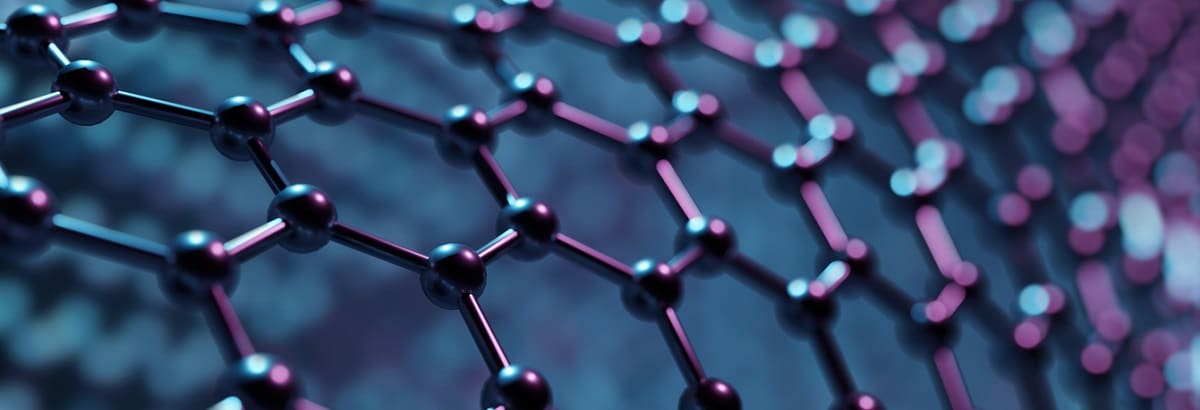Cristina Leon Vera | 22/05/2025
Graphene comprises a single-dimensional layer of carbon atoms. The material has grabbed the attention of large corporations since its boom in 2004, thanks to its resistance, flexibility and high technical and electrical conductivity. Twenty years later, it counts as yet another extraordinary technological advance.
Although graphene’s chemical bond and structure were discovered in the 1930s, it was largely ignored for decades. Things changed in 2004, when Andre Geim and Konstantin Novosiólov managed to isolate it at room temperature, extracting a very thin sheet (its thickness is the minimum allowed under the laws of physics) that maintained exceptional physical properties. We talked with Mar García Hernández, research professor at the CSIC Madrid Institute of Material Sciences about the advances and obstacles currently facing graphene.
Mar, a renowned researcher in the field of advanced materials, talked to us before in 2019 about the progress being made in areas as diverse as aeronautics and construction. Today, still not having reached its maximum potential, graphene has also taken decisive steps in essential sectors such as medicine and energy generation.
Progress in production and marketing
When talking about commercial exploitation, it’s important to bear in mind that not everything launched on the market is pure graphene, and that many related materials – but not identical – are garnering the attention of numerous industries. “The word graphene refers only to the monolayer of a hexagonal carbon atom network. However, numerous products are marketed, such as nanoplatelets or graphene oxide, which, although they may have a valuable functionality, don’t strictly match graphene,” explains the expert. These variables have enabled the production of ever more perfect graphene films, leading to optimal integration into electronic devices.
One of the main historical challenges for graphene has been on the economic front. In addition to having to compete with other well-developed technologies, which have benefitted from decades of sustained investment and, therefore, better implementation in value chains, the graphene industry has had to find a way to produce on a large scale and at an affordable cost. “Great progress has been made in understanding and perfecting the synthesis of different graphene, thanks to successful methods such as liquid exfoliation of its different variants, together with the formulation of graphene-based inks for use in printing processes, as well as chemical deposition techniques in the steam phase,” García explained. However, she acknowledges that there is still room for improvement. “The processes that control material defects still need to be optimized, as they can influence their properties”, she points out. In her opinion, the key to reducing graphene lies in increasing demand, which will bring with it economies of scale.
Graphene’s role in the green energy transition
Sustainability has shifted from being part of business philosophy to becoming the central and strategic axis of economic development. Graphene can be a solution and lever in many sectors. “The use of graphene is being studied in the manufacture of self-repairable, more durable cement and asphalts with more features, which could help reduce the construction sector’s carbon footprint. In energy, in addition to being used in batteries and supercapacitors, graphene is now being applied to green hydrogen production and storage to significantly reduce the cost of expensive metals,” Mar explains. Graphene’s lightness contributes to the production of many smaller structural elements, which is very relevant for the aeronautics and automotive industry, given the related fuel savings.
Graphene can improve the efficiency and effectiveness of renewable energies. “In the energy sector, graphene compounds are more resistant and less heavy, which alleviates the transport of elements such as wind turbine blades,” says the CSIC expert. The same material is suitable for the “development of coatings and for self-diagnosis and repair.”
Future prospects
One of the most successful graphene implementations has been in the technology sector, as its properties make it an ideal base for applications in high-power electronics, cooling devices and the manufacture of microchips. The most noteworthy milestone in recent years was the discovery of a family of two-dimensional and semiconductor materials that could be combined with graphene, thus improving its properties.
All of these advances are just the beginning of a broader future for this material, which will cover all types of industries. “There are important applications being developed in the aerospace industry, in ultra-flexible electronics, in smart textiles and biomedical advances,” the expert says. In fact, in the latter field, graphene is transforming diagnosis and prevention, thanks to biosensors based on graphene-embedded transistors that allow for continuous health monitoring. In addition, graphene foam is capable of curing spinal injuries by reconnecting damaged tissue. Despite the challenges ahead, García is optimistic, and believes that the production and use of graphene will increase, as long as innovation is maintained and production scalability is promoted.
Article collaborators…

Mar García Hernández (Madrid, 1959) is a Professor of Research at CSIC, Spain’s Spanish National Research Council. She completed her doctorate at the CSIC Institute of Matter Structure and has worked at the J. Heyrovsky Institute (Czech Academy of Sciences, Prague), the École Polytechnique Fédérale de Lausanne and the Rutherford Appleton Laboratory (Oxfordshire, United Kingdom).
She has published more than 270 scientific articles in international journals, directed numerous national and European research projects, as well as doctoral theses, and is the coauthor of several patents.





